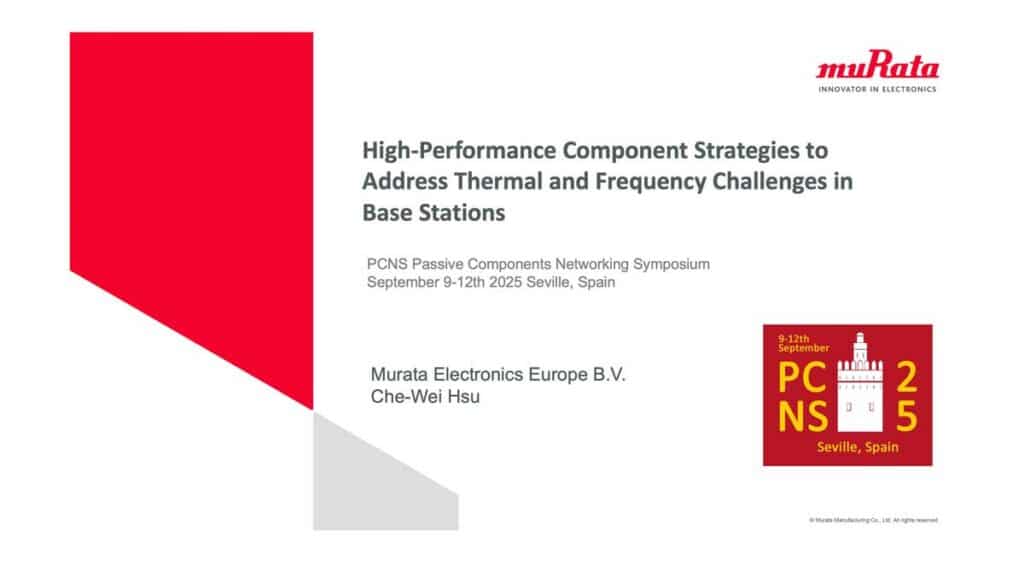The paper “High-Performance Component Strategies to Address Thermal and Frequency Challenges in Base Stations” was presented by Che-Wei Hsu, Murata Electronics Europe B.V., Hoofddorp, The Netherlands at the 5th PCNS Passive Components Networking Symposium 9-12th September 2025, Seville, Spain as paper No. 5.1.
Introduction
The transition from 4G to 5G and the future implementation of 6G networks has significantly increased the performance demands placed on base station power amplifiers (PAs).
These systems now require enhanced thermal management and superior high-frequency performance to support wide bandwidths and higher power efficiency.
The integration of active antenna units (AAUs), which combine power supply units (PSUs) with remote radio units (RRUs), has created shared thermal environments that intensify heat management challenges. This evolution necessitates innovative component selection strategies to ensure reliability, efficiency, and signal integrity in next-generation telecommunication infrastructure.
Key Points
- Base station PAs face extreme thermal conditions, often exceeding 125–150°C, and require robust components to withstand temperature cycling and material stress.
- Higher frequencies in 5G and 6G (up to terahertz bands) demand capacitors with high Q values, low ESR/ESL, and precise tolerances to maintain signal integrity.
- Advanced multilayer ceramic capacitors (MLCCs) offer solutions with thermal resilience, compact size, and superior high-frequency performance.
- Design strategies must balance thermal management, frequency response optimization, space constraints, and reliable current handling.
- Component selection increasingly relies on low-inductance designs, high-capacitance MLCCs, and temperature-stable dielectric formulations.
Extended Summary
Modern base station power amplifiers operate in environments with temperature peaks up to 150°C and frequent thermal cycling from -70°C to +180°C. These conditions can lead to component failures such as solder joint cracking, dielectric degradation, and metal migration. The move toward integrated AAU architectures exacerbates thermal stress by increasing PSU temperatures, impacting mean time between failures and overall system reliability. To address these issues, designers must select capacitors capable of sustaining performance under severe thermal conditions, including products rated for 150°C with appropriate voltage derating.
In parallel, the expansion of wireless technology into millimeter-wave and terahertz frequencies requires components optimized for high-frequency operation. Capacitors used in matching networks and DC-blocking applications must maintain high Q factors, low parasitic effects, and stable capacitance across temperature ranges. High-frequency performance is closely linked to package size, with smaller components offering higher self-resonant frequencies but reduced power handling. Advanced MLCC ceramic capacitor designs such as the GJM and GQM series leverage copper electrodes and low ESR/ESL structures to achieve the necessary performance for next-generation base stations.
Space and thermal constraints drive the need for miniaturization and efficient designs. Modern MLCCs address these challenges by offering high capacitance in compact packages, low-inductance configurations, and three-terminal designs that reduce radiation noise and improve decoupling efficiency. Such designs not only enable higher circuit density but also reduce self-heating, contributing to improved thermal management in tightly packed base station modules.
Effective component selection involves comprehensive evaluation of thermal, electrical, and mechanical requirements. Designers must consider real operating conditions around PAs, ensuring proper current handling, ESR/ESL optimization, and frequency response. High-Q capacitors in miniature packages and large-capacitance MLCCs allow for component count reduction, space savings, and improved system reliability.
Conclusion
The evolution toward 5G and 6G base stations requires advanced thermal and frequency management strategies supported by high-performance MLCC technologies. Capacitors featuring high thermal resilience, low ESR/ESL, and precise tolerances enable reliable operation in extreme environments while maintaining signal integrity. As wireless infrastructure continues to expand into higher frequencies and denser configurations, future capacitor development will focus on enhanced miniaturization, improved temperature capabilities, and optimized materials for emerging frequency bands. Selecting the right capacitors is essential to achieving performance, efficiency, and reliability in next-generation global connectivity infrastructure.
